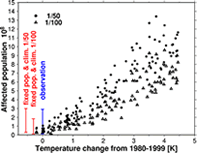River flooding is one of the major environmental hazards that are anticipated to become more frequent in future, because anthropogenically induced climate change is expected to intensify the global water cycle. Currently, 20 to 300 million people per year are affected by floods that threaten both social security and sustainable development. However, to date there has been no adequate estimate of the future global population that might be at risk of flooding.
Now, Shinjiro Kanae in the Department of Mechanical and Environmental Informatics at Tokyo Institute of Technology and his colleague Yukiko Hirabayashi have used a global-scale river discharge simulation to make the first estimate of future populations at risk of flooding. The researchers used their simulation to detect extreme conditions of river discharge, and applied the results alongside a distributed population dataset.
The results indicate that in the case of 3 ℃ warming above the 1980-1999 temperature average, approximately 300 million people could be at risk, even in years of relatively low flooding. This number corresponds to the number of people affected by a devastating flood every year at present. If the temperature increase is greater than 3 ℃, the flood-affected population would likely be even larger. Therefore, the famous '2-degree' tipping point turns out to be a reasonable guideline for continental river flooding.
Reference
- Y. Hirabayashi & S. Kanae
- Hydrological Research Letters 3, 6-9 (2009)
- Department of Mechanical and Environmental Informatics
- Department website: http://www.mei.titech.ac.jp/index-e.html

- Title of original paper: First estimate of the future global population at risk of flooding
- Digital Object Identifier (DOI): 10.3178/hrl.3.6
Figure caption: The predicted population affected by floods versus the change in global mean surface air temperature in the 21st century. For reference, the variability range of the actual flood-affected population in the past, the variability range of the flood-affected population with climate model outputs in 1901–2000, and the population fixed at the year 2000 value are shown at the left.

. Any information published on this site will be valid in relation to Science Tokyo.



